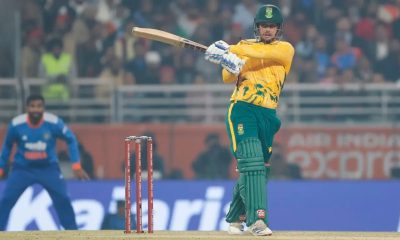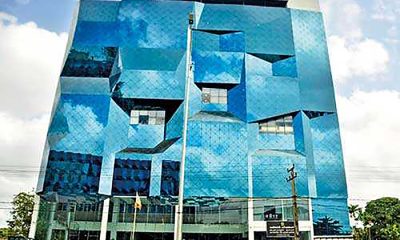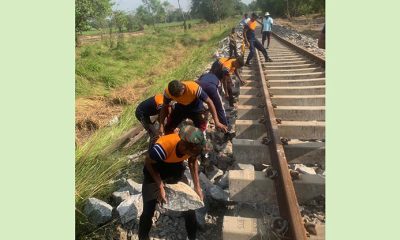Features
Ministry of Industries: Working with Mr. Cyril Mathew
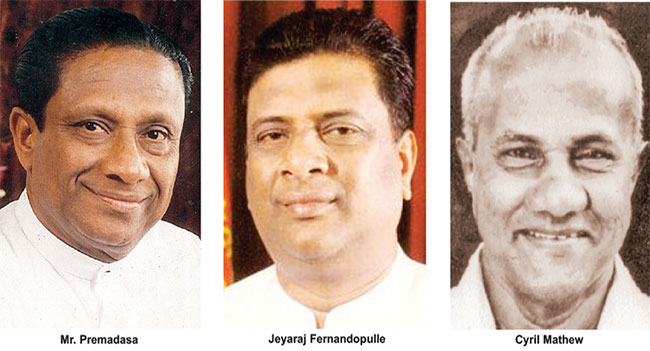
(Excerpted from the Memoirs of Chandra Wickremasinghe, Retd. Additional Secretary to the President)
In the National Housing Authority where I worked after returning from Canberra, I received the complete support of my friend Dunstan Jayawardena who was Chairman of the Authority, to effect an organizational restructuring of the Authority, recruit new technical personnel and revise the existing salary structure. The reorganization enabled officers who had come on secondment to the Authority from the Housing Dept., to exercise the option of staying on in the Authority as permanent employees of that organization. They benefited substantially by being placed at higher levels in the organizational hierarchy as well as receiving much higher salaries. With time, I was happy to note many of these officers, coming to occupy the highest management positions including those of Chairman, General Manager and Deputy General Manager.
The Authority was indeed a hive of activity with Minister Mr. Premadasa in his characteristic manner, pushing the implementation of the numerous housing projects he commenced throughout the island. He worked with incredible energy and commitment, virtually driving all officials to follow suit. However, following certain differences I had with the Secretary to the Ministry over the appointment of Managers to the Authority, I thought it best to leave the set up. Fortunately for me, Mr. Premadasa happened to be out of the island at the time which facilitated my exit without much fuss.
There were two positions available to me to move into viz. Deputy Commissioner of Food and Director /Corporations in the Ministry of Industries. I opted for the latter position where I had to work with Minister Mr. Cyril Mathew.
The Ministry of Industries, Science and Technology
The Ministry had at the time, 47 Corporations and Statutory Boards coming under its purview. These included, certain giant Corporations such as Petroleum, Steel, Ceramics, Paper, Salt, Fertilizer, Tyre etc. I got down to work straight away and got involved in the nitty gritty of things. Mr. Mathew who had a sharp mind, had the not too uncommon weakness of surrounding himself with party loyalists, the more qualified of whom were selected fortunately, as Chairmen of the many Corporations coming under the Ministry while the brawny types who had their own uses, were given the post conveniently designated ‘Working Director’. This latter category had confabulations with the Minister when certain disruptive activities had to be planned and carried out like breaking up rival party rallies, street marches etc.
I must however say that Mr. Mathew never interfered with the work assigned to me. Through the grape vine he may have learnt perhaps, that I was attending to my work conscientiously. Within one year he promoted me as Additional Secretary in the Ministry much to the chagrin of certain senior colleagues in the Service, some of whom, I learnt later, had even taken the matter up with Mr. DBIPS Siriwardhana, Secy. Public Aministration at the time. Mr. Siriwardhana, I was told, had made it clear to them that the appointment of Additional Secretaries was a matter for the Minister concerned.
Chairing Tender Boards
I found the work in the new Ministry quite challenging, having to Chair Tender Boards of about 15 Corporations on an on –going basis. Additionally, I was appointed to Chair the standing Tender Board in Agro-Chemicals of the Petroleum Corporation which work alone, was quite a handful. I must say that the Minister had complete faith and trust in my integrity and aptitude in handling all these Tender Boards. I must also reiterate here for the record that Minister Cyril Mathew never interfered with any of my ‘tender’ work. I must however, further state here with much regret, that certain friends of mine (outside the Ministry) did try to influence me on tender matters, going to the extent of asking me to remain silent during certain Tender Board meetings. This I vehemently declined to do, stating categorically that as Chairman of a Tender Board, it was clearly my duty to ensure that a poor country like ours, should get the best supplies on offer and also ensure that we get our money’s worth. Happily for me, word spread around quickly and I was never bothered thereafter with such unfortunate requests. What I would like to stress here is that once people realize that you cannot be bought over, you are seldom approached by these wheeler –dealer types with their sly requests.
As a Director of the Central Environmental Authority, I had the benefit of attending a Seminar at D.S.E. Berlin in June-July 1982, on Industrial Pollution and Abatement. The CEA also sponsored my participation at a seminar on the pollution of lakes and reservoirs in Tokyo, Japan in September 1984.
Most of the 47 Corporations and Statutory Bodies coming under the Ministry had professionals as their Chairmen who for the most part, discharged their duties with due diligence and competence. However, there were a few Heads of Corporations who abused their positions and tried to make a fast buck. The Minister who had his own unofficial grapevine in this regard, was kept well informed by his many informants, of any irregularities in the numerous Depts. and Corporations coming within his purview.
I recall the Minister summoning me to his room one day to say that he was not at all happy with some of the untoward goings on in the Ceramic Corporation as he had received many complaints from customers about commodes and bathroom fittings cracking up within an year or so of their purchase. He instructed me to visit the Ceramic Factory in Piliyandala with Deputy Chief Accountant Sivaguru and check on the procedures followed and report to him. Siva and I accordingly, decided to visit the factory the following day. Interestingly, on the morning of our scheduled visit to the factory, I received an anonymous telephone call enquiring from me whether I was going to inspect the factory that day. On my replying in the affirmative, the caller who refused to identify himself, said in a matter of fact tone ‘We are having the kiln ready for you and the Accountant when you visit us’.
I replied that we were coming in any case, as it was our duty to inspect the factory and report to the Minister. Siva and I had our suspicions as to who the anonymous caller was as we had been forewarned that there was a supervisor with political backing who was ruling the roost there. We were not going to be cowed down by any threats and just laughed the whole thing off saying that ‘we would face things as they come’! We were also told that this unsavoury character was in the habit of even assaulting employees who did not do his bidding and was virtually terrorizing the entire place. When we visited the Piliyandala Factory as scheduled, we were met by the General Manger who though a nice person, looked a rather docile individual. We were thereafter, taken round the factory and shown the different stages of the entire production process.
At this stage, I requested specifically that we be taken to the kiln and the supervisor concerned promptly led us there. Siva and I deliberately got close to the kiln and peered into it’s blazing interior. Siva, who was a qualified Chartered Accountant, questioned the supervisor closely on the duration of time assigned for each stage of the production process etc. Having collected all the required detailed information both from the GM and the Supervisor concerned ,we retired to the GM’S office and obtained whatever further information we deemed necessary for our investigation and left the factory.
On our return to the Ministry, Siva and I pored over the notes and the relevant information we had taken down on our visit. It became clear to us that the problem of breakages lay in the deliberate acceleration of the production process particularly at the stage of firing of the ceramic ware in the kiln. By such deliberate acceleration, the culprits had ensured an output higher than what was reflected in the production statistics, enabling them to divert the created excess clandestinely, out of the factory to be sold to shops outside.
The following day we gave our report to the Minister explaining in detail what we had discovered. The Minister told us that his suspicions about the people behind the racket, had been confirmed by our findings. Late that evening, the Minister telephoned me and said that he had shown our report to a certain gentleman who was he said, with him at the time. I was aware that this gentleman was an influential person in the political set up at the time. The Minister then said that the particular gentleman would like to speak to me regarding the concerned subject. I recall clearly overhearing certain audible protests made by the gentleman concerned at the other end. Eventually, this gentleman came on line and spoke to me apologetically saying that although he had had suspicions about this particular supervisor, he had not till the time the irregularities had been revealed by our inspection, been able to confirm his suspicions. He further assured me that he would initiate an inquiry against him and see that he was disciplinarily dealt with. He further said that he had assured the Minister that he would guarantee that no irregularities would be permitted to occur in the factory in the future. The Minister came on line again and thanked me and Siva for giving him the report while apologizing, in his characteristically gentlemanly manner, for having disturbed me at that late hour.
Poverty the biggest polluter in developing countries
This was also the time when developed countries were obsessed with the spectre of a rapidly depleting ozone layer and were frantically adopting sophisticated pollution prevention measures in their industrial production processes. This was the run up to the Kyoto Protocols. They were equally anxious to impose these high standards in the running of ‘struggling’ industries in developing countries which were trying desperately to break free of the poverty trap. While having a conversation with the Minister on the subject, I casually expressed the view that it was grossly unfair of developed countries to badger developing countries to conform to these high standards of pollution prevention, as these highly industrialized, affluent countries had built up their economic and material prosperity on decades of indiscriminate abuse of the environment and on the worst forms of exploitation of women and children.
Developing countries on the other hand, which suffered from widespread poverty and were struggling to industrialize, could not possibly think of maintaining pristine environments by investing in costly additional facilities to minimize environmental pollution, which meant burdening the end product by the additional cost that had to be incurred thereby, which clearly meant eroding the competitive edge our exports enjoyed. Furthermore, I said that China, was the least concerned, despite the pressures brought to bear on them by the West, about maintaining pollution standards, in their determined drive towards rapid industrialization, which was accorded the highest priority in their single minded endeavour to reduce mass poverty in that country. I also said that our major concern should be the alleviation of poverty through a sustained developmental thrust ,as poverty was our biggest polluter.
The Minister who had listened carefully to what I said, wanted me to prepare a brief note incorporating these points and hand it over to Sarath Perera who was the Additional Secretary handling the subject. This was accordingly done by me. To my surprise a major headline carried in the following day’s newspapers read – ” The Ministry of Industries takes the view that the strict industrial pollution standards followed in the developed Western countries need not be adopted here.” It should be remembered that these decisions were taken more than 30 years ago when more than 60% of the population of this country was living at subsistence level, occupying substandard housing with no proper facilities for sewage and waste disposal.
Poverty alleviation was hence, a major policy imperative we had to pursue relentlessly. There was no gainsaying that there was widespread environmental pollution stemming from widespread poverty. But the hard logic that had to be underscored was that, poverty was indeed, irrefutably, the biggest polluter in poor developing countries. This was why they were according the highest priority to poverty alleviation and were trying frantically to break loose of what seemed an inexorable poverty cycle, through rapid industrilisation.
I also benefitted by attending a workshop on “Modern Management Techniques” at the D.S.E. Berlin in June – July 1983. I had to leave the Ministry of Industries under somewhat distressing circumstances. Mahinda Bandusena who was Senior Asst. Secy. of the Ministry at the time, and I were entrusted by the Minister the rather unenviable task of handling disciplinary inquiries against certain errant Heads of Corporations coming under the Ministry. It was a painful task given to us as some of the Corporation Heads were our close friends. But the Minister did not seem to be affected by these sensitivities and insisted that we carry on with these Inquiries.
I remember one particular case where I conducted an inquiry against a Chairman of a Corporation who had defalcated a substantial amount of money. There was enough evidence to conclude that the said Chairman had defrauded the Corporation and my report was submitted to the Minister along with my findings. The Minister summoned me the next morning and I found the Chairman seated before the Minister with his head bowed. The Minister at that stage gave me the file containing my report asking me to read the section on my findings. At the end of it, the Minister asked the Chairman what he had to say. As the Chairman remained silent, the Minister berated him saying that he was being badly let down by the Chairman and wanted the latter to pay back the full amount of money he had misappropriated immediately. The said Chairman I was told, had post haste paid back the full amount of money and had thereafter got himself warded, purportedly seeking treatment for high blood pressure. He had remained in hospital for a week and on his return to office, had been given another severe tongue lashing by the Minister who I was told, had felt sorry for him and accommodated him in another Statutory Board in the Ministry.
I still recall vividly an incident which happened when the Ministry Votes were being debated in Parliament with myself, Bandu and other Ministry official looking on from the Officials’
Box. We were embarrassed no end when Mr. Jeyaraj Fernandopulle who was at the time in the Opposition, pointed to us and said in Sinhala –”There you can see the Minister’s Supreme Court, Mr. Chandra Wickramasinghe and Mr. Mahinda Bandusena. They are the two who sit in judgment over Chairmen of Corporations”. (Recorded in Hansard.)
All this was in addition to the normal duties I was saddled with. Mahinda Bandusena too was similarly burdened with this additional workload. The Minister who was however, impatient to have these inquiries finalized in double quick time (which would have been most unfair by the accused persons most of whom happened to be our friends), summoned the two of us to his office at Flower Road and berated us for ‘delaying’ these inquiries. We both thought that the Minister was being unfair by us and tried to explain to him why we could not possibly accelerate these inquiries. However, the Minister was in no mood to hear us out. As we left the Minister’s office I told Bandu that I was leaving the Ministry and would look for a suitable place immediately.
I telephoned Mr. DBIPS Siriwardhana that afternoon and conveyed my intention of leaving the Ministry. I remember distinctly his cynical laugh while asking me “Do you take these characters seriously? They are just birds of passage and you should not get emotionally affected by what they say”. However, as I was insistent on leaving, he asked for two days for him to try and do something. However, within half an hour, he rang back and asked me whether I was interested in the post of Additional Secy. in the new Ministry of National Security where he had just been appointed Secretary. I promptly said that I would be privileged to serve under him but at the same time expressed certain doubts about my being able to secure my release from the Industries Ministry. Mr. Siriwardhana laughed and said that Minister Mathew should be happy to see me leave, having given me a blackguarding!
The next morning Mr. Mathew called me to the Ministry and was very sweet to me. I was with him for a good two hours and in between consultations he had with officials, he asked me what I thought about some new projects that came up for discussion and also sought my opinion about certain officers who visited him that morning. I however, was discreetly reticent particularly in expressing my personal views on certain officers most of whom were known to me well. When he was about to leave office I thought it was time for me to inform him that I would be leaving the Ministry. From the manner he reacted, it was clear that it came as a shock to him.
He asked me where I was going and the Minister in charge of the Ministry concerned. When I informed him that it was the new Ministry of National Security which had been created by the President, he realized that he would not be able to block my release. He then asked me who would succeed me and when I suggested a few names he did not seem happy with them and said that he would find a suitable successor. I liked Mr. Mathew despite the reputation he had for using strong arm tactics. Apart from the last episode which he obviously regretted, going by the manner he treated me the following day, I must say that he was extremely good to me during my stay of four years in that Ministry.
However, when I was leaving the Ministry to take up the appointment as Additional Secy. in the newly created Ministry of National Security, I was somewhat amused when a member who regularly served on these Tender Boards, told me that he was happy to see me leave, as I did not make money for myself nor did I allow others to do so! Although I was momentarily taken aback by what the person said, I knew again that it was indeed, a grudging compliment paid to me.
Features
Ditwah: A Country Tested, A People United
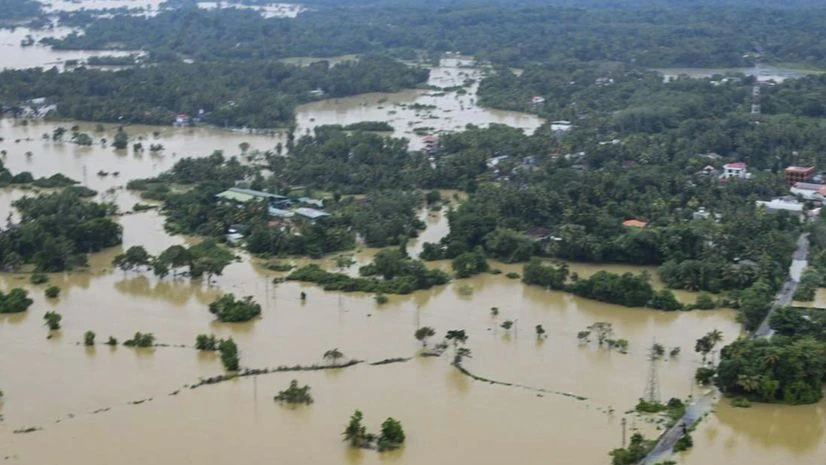
When Cyclone Ditwah roared across the island on November 27 and 28, 2025, it left behind a landscape scarcely recognisable to its own inhabitants—homes reduced to rubbles, vital infrastructure torn apart and entire communities engulfed by floodwaters that surged with terrifying speed. The storm’s ferocity carved deep scars into the island’s social and economic fabric, displacing thousands and severing lifelines that families had relied upon for generations. In its aftermath, the air hung heavy not only with the scent of mud and debris, but also with a palpable collective grief—a profound sense of loss etched on every face. As of December 9, the day of writing, the death toll had reached 635, with an additional 192 individuals reported missing. In Kandy alone, one of the most severely affected districts, 234 lives were lost. Island-wide, 12,123 families—amounting to 1,776,103 people—were displaced.
As a small island situated in the monsoon-fed waters of the Indian Ocean, Sri Lanka has long lived in intimate coexistence with hydro-meteorological hazards. For centuries, the monsoon winds that swept across the island brought not only life-giving rains to nourish paddy fields, forests, and communities, but also shaped the rhythms of daily life, agriculture, culture and even the island’s civilisation itself. Yet this same monsoon—when delayed, intensified, or disrupted—has had the power to unsettle entire ways of life and inflict widespread human suffering. Over generations, communities learned to read the sky and the sea, developing localised knowledge systems and adaptive skills to cope with the uncertainties of winds and waves. This reservoir of traditional wisdom fostered a form of social resilience deeply embedded in the island’s cultural fabric. At present, however, this traditional resilience is increasingly tested by the new realities of climate change and the growing frequency of severe cyclones.
When Cyclone Ditwah struck on November 27, 2025, it unleashed a force so violent that it reshaped many districts within hours, leaving behind a trail of destruction that stretched as far as the eye could see. Whole neighborhoods were crushed under winds that tore roofs from their foundations, while surging floodwaters swept through villages, carrying away homes, livelihoods, and the fragile sense of security people had built over generations. Roads lay fractured, communication lines collapsed, and families found themselves cut off in pockets of isolation marked by debris and despair. In the storm’s wake, the silence was haunting—broken only by the cries of survivors searching for loved ones and the distant hum of rescue teams navigating the ruins. The scale of the devastation was overwhelming, a human and infrastructural tragedy so profound that it demanded not just an emergency response, but a coordinated, compassionate, and deeply human-centered approach to crisis management.
The most devastating natural disaster Sri Lanka has experienced in recent history remains the 2004 Indian Ocean tsunami, which claimed over 35,000 lives and displaced nearly a million people. Sweeping across two-thirds of the nation’s coastline—more than 1,000 kilometers—it affected approximately 234,000 families and destroyed over a million houses. More than two-thirds of the country’s fishing fleet was obliterated. Beyond the immense human suffering, the tsunami exposed profound gaps in preparedness and underscored the urgent need for a systematic, coordinated approach to disaster risk management.
Over the last decade, Sri Lanka has increasingly confronted hydro-meteorological hazards driven by the accelerating impacts of climate change. Cyclones such as Roanu (2016), Mora (2017), Burevi and Amphan (2020), and Yaas (2021) highlight the growing frequency and severity of extreme weather events. According to the Sri Lanka – Disaster Management Reference Handbook, Cyclone Roanu brought the highest recorded rainfall in more than 18 years, triggering floods in 24 of the country’s 25 districts. Covering 1,400 square kilometers, the flooding affected nearly half a million people and inflicted damages estimated at US$600 million. Just a year later, Cyclone Mora caused severe flooding across 15 southern districts and unleashed landslides that further compounded human and infrastructural losses.
These climate-induced pressures have been accompanied by increasingly destructive monsoon-related disasters. In May 2016, the Aranayake landslide wiped an entire village off the map, killing 144 people, leaving 96 missing, and rendering hundreds homeless as their dwellings were buried under rubble. The following year, unprecedented monsoon rains caused flash floods and landslides that killed more than 210 people and displaced 630,000 across 15 districts. Subsequent monsoon seasons delivered similar devastation: in 2018, floods and landslides resulted in 24 deaths and affected 170,000 people; in 2019, heavy rains left 16 dead and displaced more than 7,000. Even in 2020, despite the successful evacuation of more than 75,000 residents ahead of Cyclone Burevi—an example of improved preparedness—post-cyclone flooding still affected over 100,000 people and destroyed or damaged nearly 4,000 homes.
Compounding this pattern of extreme rainfall and flooding is the paradoxical increase in drought conditions, another manifestation of climate variability. The worst drought in four decades struck between October 2016 and October 2017, affecting 2.2 million people across the North Western, North Central, Northern, and Eastern Provinces. From March to May 2020, another severe drought impacted more than 500,000 individuals in 14 districts, forcing the government to implement emergency drinking water distribution across six provinces. These cycles of excess and scarcity are further aggravated by the seasonal rise in vector and rodent-borne diseases—most notably dengue fever and leptospirosis—adding another layer of complexity to Sri Lanka’s disaster management landscape.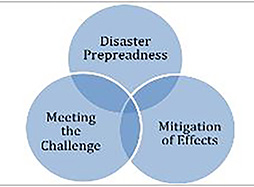
Societal Resilience in Disaster Management
As these converging crises demonstrate, Sri Lanka’s vulnerability to climate-driven disasters is no longer episodic but structural—woven into the lived reality of communities across the island. Yet amid repeated cycles of loss and recovery, what stands out most is not only the scale of devastation but the remarkable capacity of ordinary people to adapt, support one another, and rebuild their lives. This enduring strength points to a deeper truth: effective disaster management cannot rely solely on institutions or technologies; it must draw upon—and reinforce—the social resilience embedded within communities themselves.
Having lived under the influence of monsoons for generations, traditional communities developed sophisticated knowledge and skills to cope with nature’s unpredictability. Long before formal disaster management systems existed, villagers relied on environmental cues and collective action to prepare for seasonal threats. In the upstream and valley areas of the Kalu Ganga, for example, older generations still recall how communities repaired boats and rafts through shramadana well before the rainy season began. They observed the behavior of birds, animals, and changes in wind patterns to decode early warning signs that modern meteorology would later confirm.
Such practices demonstrate that traditional communities were not merely passive recipients of natural hazards; they were active interpreters of their environment. Their resilience stemmed from a deep ecological intimacy, a lived knowledge system refined through experience. Today, there is immense value in unpacking this traditional knowledge and synergising it with modern technology—not to romanticise the past, but to strengthen contemporary preparedness.
The Role of Community and the Political Domain
Building societal resilience requires more than cultural memory; it demands structured collaboration between communities and the political system. While communities are often the first responders in any disaster, the political domain plays a crucial role in mobilising, legitimising, and coordinating their efforts. Transforming political will into national will requires an organic articulation between civil society and political leadership—a partnership where both domains reinforce one another rather than operate in isolation. Within this broader framework, disaster management encompasses three equally critical components:
Disaster Risk Management
In each of these, the state has a vital role—from policy formulation to resource allocation, coordination, and accountability. Yet, the effectiveness of state-led initiatives ultimately hinges on the strength of the relationship between institutions and the communities they serve.
Beyond Culture: Technology and Institutions as Pillars of Resilience
While socio-cultural resilience forms an indispensable foundation, it is no longer sufficient on its own, given the scale and complexity of contemporary climate-induced hazards.
Modern disaster risk management relies on a robust interface between technology, institutional networks, and community participation. Advanced and accessible communication technologies—early-warning systems, mobile alerts, satellite data, and community-level dissemination platforms—play a crucial role in transforming timely information into effective action.
But technological tools reach their full potential only when supported by strong institutional structures, in both formal and informal, capable of mobilising people and resources rapidly and equitably. Thus, societal resilience can be understood as a system supported by three interdependent pillars.
Societal Resilience
When these elements function in harmony, the collective capacity to withstand and recover from disasters is significantly enhanced. Ultimately, social resilience is not merely the ability to endure shocks—it is the ability to recover with dignity. A humane disaster management system recognizes the agency, knowledge, and lived experiences of affected communities. It integrates cultural wisdom with modern capabilities, fosters trust between citizens and institutions, and ensures that every step of the disaster cycle reflects empathy, inclusion, and respect. 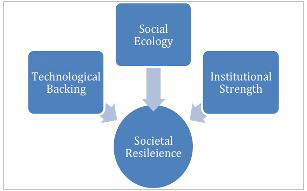
Immediate Community and Government Responses to the Crisis
Within ten days of the Ditwah disaster, the Sri Lankan government succeeded in rapidly mobilizing the security forces, key institutional structures, political leadership, and community organisations to confront the crisis. Given the scale and depth of the devastation, meeting the challenge and mitigating its effects seem to be a formidable task. The armed forces and government departments, supported by unaffected communities, provided exceptional assistance to meet the initial challenge. People in the South—often guided directly or indirectly by local political/community leadership—volunteered in large numbers, travelling to the hills to support recovery efforts. Much of the initial work of clearing debris and cleaning homes was carried out through community participation. Infrastructure repairs, particularly the restoration of roads, water supply, and electricity, were undertaken through coordinated action by relevant government agencies who worked tirelessly day and night. As a result, nearly 80 per cent of essential infrastructure was restored within ten days, with the exception of the severely damaged railway network, which requires longer-term reconstruction.
In the immediate aftermath, the government declared a nationwide state of emergency under the Public Security Ordinance, enabling the rapid deployment of resources across sectors. Through the Disaster Management Centre (DMC) and relevant ministries, authorities activated emergency operations: evacuation orders were issued in high-risk flood and landslide zones, shelters were established across the country, and search-and-rescue missions commenced immediately after landfall.
Concurrently, the government announced a comprehensive relief and recovery package. Affected households received allowances for cleaning and resettlement, support for temporary accommodation, and financial assistance for the repair or reconstruction of damaged homes. Immediate access to financial resources—including a Rs. 30 billion contingency allocation that did not require prior parliamentary approval—enabled swift implementation. The declaration of this extensive and unprecedented relief package played a key role in restoring hope and strengthening the self-confidence of affected communities.
Recognizing the magnitude of the crisis, the government established a special recovery fund that brings together public and private sector contributions to support long-term reconstruction, infrastructure repair, and livelihood restoration. Involving prominent private sector leaders—including those who are not aligned with the ruling administration—alongside government officials and key ministers is intended to build trust within the business community and reinforce transparency in the fund’s management. The substantial international assistance received and pledged reflects a renewed confidence among external partners in the government’s ability to manage funds transparently and ensure that aid reaches intended beneficiaries. Sri Lanka further collaborated closely with international and humanitarian agencies to scale up multi-sector support. Organizations such as the World Food Programme (WFP), International Organization for Migration (IOM), and World Health Organization (WHO) mobilized food, water, medical supplies, shelter materials, and rapid-response teams—often in coordination with government efforts—to reach displaced persons and vulnerable populations, particularly in remote and landslide-prone areas.
During this ten-day period, the President personally attended the district coordinating committee meetings in all cyclone- and flood-affected areas. These meetings brought together political leaders—both from the ruling party and the opposition—along with key administrative officers and representatives from the relevant line ministries to review disaster response, mitigation measures, and recovery needs. The manner in which the President raised issues, sought clarification, and directed action demonstrated a high level of preparation and a clear understanding of the scope and complexity of the damage. His engagement signaled a proactive and informed approach to crisis governance, contributing to more coordinated and timely interventions across affected districts.
Thus far, these measures largely pertain to confronting the immediate challenge and mitigating its impacts. Yet effective mitigation must ultimately lead into long-term recovery planning and strengthened preparedness for future climate-induced crises. Ditwah is not the first or the last. Climate change has altered the frequency, scale, and unpredictability of extreme weather events, making it clear that Sri Lanka must now learn to live with recurring climate hazards as a structural condition rather than an episodic disruption. This requires a sustained investment in resilient infrastructure, risk-sensitive development planning, and community-level adaptive capacity. In this sense, the response to Cyclone Ditwah should not only be understood as an emergency undertaking, but also as a critical moment to embed long-term climate resilience into national policy and institutional practice.
Lessons learned
The devastation wrought by Cyclone Ditwah has once again tested Sri Lanka’s institutional capacity, the NPP political leadership and peoples’ resilience. Since the 2004 Tsunami, the country has made significant progress in establishing organisational structures and policy frameworks for disaster management, making it a central domain of contemporary statecraft. Yet, the experience of Ditwah underscores the need for further strengthening in four key areas. First, given the multiplicity of ministries and agencies involved—from the Ministry of Disaster Management and the National Council for Disaster Management to the Disasters Management Center, the Meteorological Department and the National Disaster Relief Services Centre—clear mechanisms are essential to avoid overlap and ensure coherent, efficient action.
Second, disaster preparedness and response must harness the collective capacities of state institutions, NGOs, and community-based organisations, whose collaboration is indispensable for effective disaster risk governance. Third, the integration of traditional knowledge systems—rooted in long-standing practices of environmental stewardship and community resilience—should inform planning and implementation, complementing modern technology and institutional expertise. Finally, in a multi-ethnic, post-conflict society, sensitivity to ethno-political dynamics is imperative across all three phases of disaster management: preparedness, emergency response, and post-disaster recovery.
Ultimately, Cyclone Ditwah revealed both the vulnerabilities and strengths of the nation—demonstrating that while Sri Lanka’s systems were tested, its people were united in response, reaffirming the country’s capacity to confront adversity through collective resolve. The spontaneous networks of support that emerged in the cyclone’s aftermath demonstrated that unity is not merely an aspiration but an operational force in moments of crisis. In reaffirming the country’s capacity to confront adversity through collective resolve, the response to Ditwah offers a powerful reminder that the resilience of the people remains Sri Lanka’s most reliable foundation for future challenges.
by Prof. Gamini Keerawella ✍️
Features
Rare Seahorse discovered in Sri Lankan waters sparks urgent conservation debate

Sri Lankan marine researchers have formally documented the presence of the rare and Vulnerable Three-Spot Seahorse (Hippocampus trimaculatus) in Sri Lankan waters for the first time, an important milestone in the country’s marine biodiversity records.
The discovery was made through the examination of four dried specimens collected from fishermen operating off the southern coast near Madiha, nearly 150–200 km offshore. The evidence confirms that the island’s marine ecosystem hosts a greater diversity of seahorses than previously recognized.
Until now, only two species—Hippocampus kuda and Hippocampus spinosissimus—were scientifically confirmed in Sri Lanka, both largely linked to the northwestern lagoon systems. This discovery shifts that narrative southward.
Lead scientist Janamina Bandara emphasised the importance of the breakthrough, saying the identification not only verifies the species’ presence but also extends its known distribution range in the Indian Ocean.
He told The Island:”This is the first authentic record of Hippocampus trimaculatus from Sri Lankan waters. This species was assumed to occur here based on regional presence, but until now, we lacked verified scientific proof.”
Found in an Unexpected Habitat
While seahorses are typically associated with seagrass beds, shallow estuaries, or mangroves, the discovery revealed a surprising observation—these specimens were found attached to floating masses of marine debris.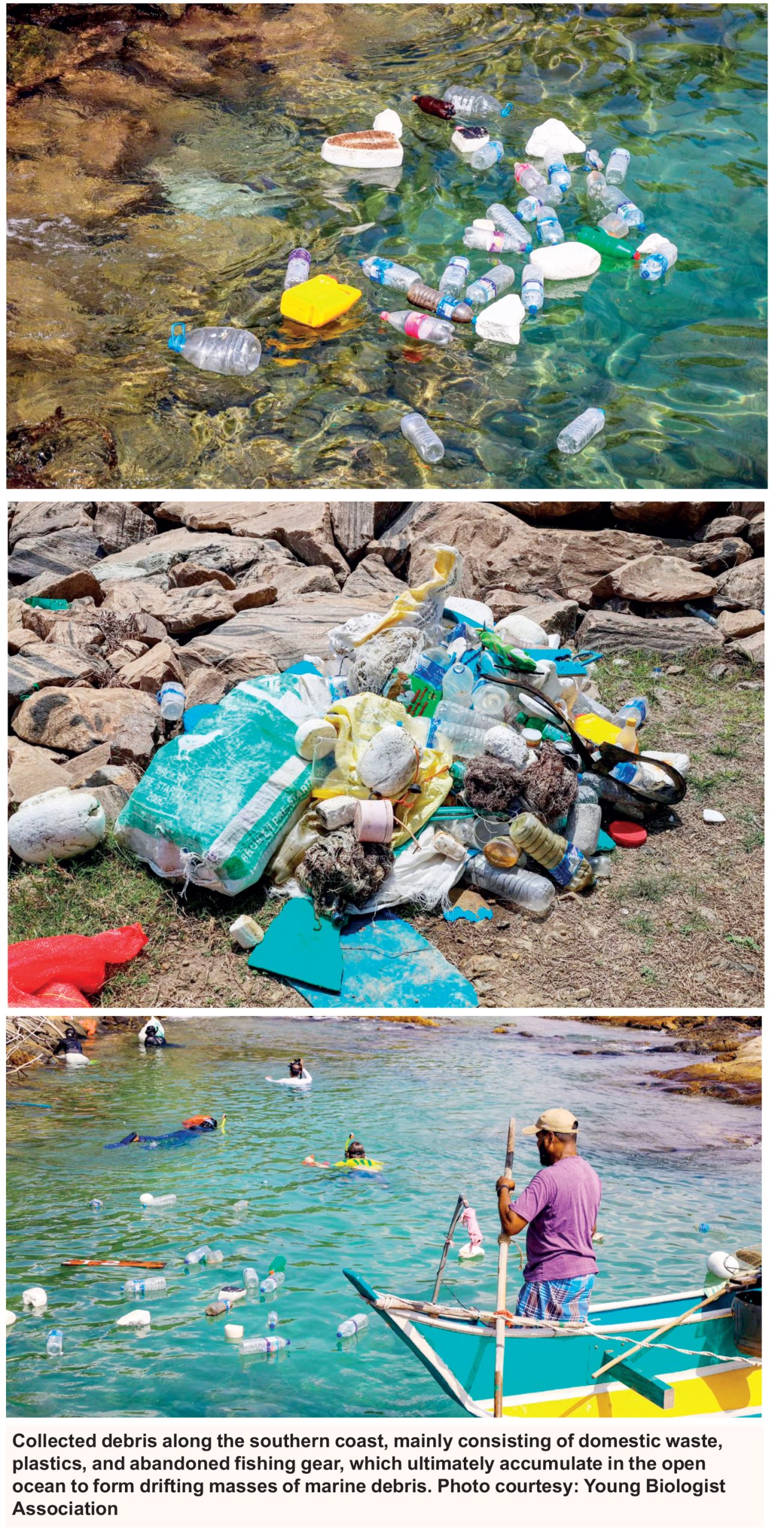
Bandara described it as one of the most unusual natural behaviours documented in local marine fauna.
“The specimens appear to have utilised drifting debris as habitat, which has not been explicitly recorded before,” he explained.
Photographs obtained from young field biologists show pieces of plastic waste, frayed fishing nets, fabric residues, and other floating refuse entangled into large drifting clusters.
Marine scientists say this phenomenon—informally referred to as “floating artificial reefs”—has been increasingly documented elsewhere in Asia and the Pacific. However, Sri Lanka has lacked records until now.
Bandara added that the drivers behind such habitat use remain unclear, raising questions about whether this behaviour reflects adaptation or desperation.
Specimens Documented, Sexed and Archived
The research team collected four specimens—one male and three females—over two separate encounters, in March 2024 and June 2025. Measurements included head-to-snout ratios, ring counts, and coronet shape, all critical criteria in identifying seahorses.
“All diagnostic features matched published descriptions, including distinct hook-shaped cheek and eye spines,” Bandara confirmed.
The specimens have since been deposited at the University of Ruhuna for long-term academic reference.
Illegal Trade Still Active
The finding has also shed light on the continuing illegal trade of dried seahorses in Sri Lanka—an industry long suspected, but seldom traced with scientific evidence.
The specimens originated from fishermen who admitted they sell dried seahorses to intermediaries and tourists. The team found that prices vary by size and buyer type.
“Smaller specimens sell for roughly Rs. 1,000 locally, while foreign buyers pay up to Rs. 5,000. Larger specimens fetch significantly more,” Bandara said.

Map. Known distribution of Hippocampus trimaculatus with the current study site indicated. Red dots: confirmed research-grade observations (n = 76) of the species from iNaturalist. Blue dot: study site location (Madiha coast, Southern Sri Lanka).
Many dried specimens are reportedly converted into gold-plated pendants, marketed under the claim of bringing luck and prosperity. In some tourist markets, dried seahorses are sold discreetly alongside shells and corals.
While enforcement exists, Bandara says it remains largely symbolic.
“Raids happen, but are limited. Without awareness among fishermen and tour operators, the trade will continue,” she said.
Global Conservation Context
The Three-Spot Seahorse is listed as Vulnerable by the IUCN Red List and is protected under Appendix II of CITES, meaning its international trade requires permits. The species faces high risk from:
Bycatch in trawl fisheries
Rising demand from Asian traditional medicine markets
Rapid habitat decline due to marine pollution
Slow reproductive turnover
Seahorses exhibit monogamous pair bonding and unique male pregnancy, making their populations extremely fragile when harvested.
Sri Lanka, positioned at a central point in the Indian Ocean trade network, remains vulnerable to illegal wildlife trafficking routes.
Bandara emphasised that biodiversity verification has regulatory relevance.
“Scientific records strengthen diplomatic and policy decisions. Without confirmed presence, enforcement remains weaker,” she explained.
Calls for Greater Action
Following the discovery, the research team is urging local authorities and NGOs to prioritise:
Awareness programmes for coastal communities
Monitoring of multi-day fishing vessels
Inclusion of seahorses in biodiversity assessments
Tourism-season enforcement in southern coastal markets
Bandara believes this new evidence allows Sri Lanka to become an active contributor to global seahorse conservation efforts.
A Turning Point for Marine Biodiversity Research
Beyond the immediate conservation implications, this finding marks one of the most scientifically significant marine records of recent years.
It suggests that Sri Lanka’s offshore ecosystems are both understudied and vulnerable to emerging human-driven pressures. Researchers now believe more undocumented marine species may inhabit local waters, awaiting formal identification.
“This discovery is not only a scientific milestone but also a reminder that our oceans hold species that are disappearing faster than we are documenting them,” Bandara said.
As marine debris continues to accumulate and demand for illegal ornamental wildlife persists, researchers warn that scientific discovery alone will not ensure the species’ survival.
Bandara says what happens next will determine the fate of this newly confirmed marine icon.
“If we act now—educate, regulate and monitor—we stand a chance to protect these animals before they vanish unnoticed.”
By Ifham Nizam ✍️
Features
Human-elephant conflict and housing needs of villagers

During the recent Ditwah cyclone, elephants were seen floating in treeless floodplains that were once their forest habitats. On a good-weather day in 2017, near Kokilai, the Navy found a pair of elephants riding waves after a beach outing two kilometers offshore in the high seas. Divers guided them ashore after a 12-hour struggle. Trains barrel through elephant herds regularly, decapitating half a dozen in one tank. A herd of elephants over 100 parades across a highway serenading motorists stuck in a kilometer-long traffic jam. Recently, adding insult to injury, a lone elephant was sitting deep inside a latrine pit behind a small house, and was dug out by a caterpillar tractor. A speeding bus ran over and killed a baby elephant, and police shot dead the mother who stood crying over her baby’s body. The tusker named Sinharaja was still a baby when the Army pulled it out from an agri-well some years ago in Nuwarakalaviya. He is now royalty tasked with carrying the sacred tooth relic at the Dalada Maligawa. These extraordinary events, rubrics of a national drama, show that fates, ours and elephants, are inexorably linked.
Over 7,000 elephants and countless villagers in Sri Lanka are torn apart daily by myriads of unpleasant encounters. Our elephant population is multiplying alongside us, making these encounters even more remarkable. As the government owns all elephants and writes laws for them, it also owns the product of these encounters. Since it has law books for the villagers, too, it cannot disregard the mess its protégé, this patrician in the wild, leaves on the villagers’ doorstep. Only the government can find a lasting solution to blunt the prickly edges of this national emergency, but not without contributions from the villagers.
George Orwell wrote in Animal Farm, “Some animals are more equal than others.” But the sentimentally charged public opinion about our cultural icon cannot outweigh the burden it placed on villagers living on the edges of elephant habitats.
As will be explained later, I propose a Gam Udawa-type house for each newly married couple who choose to remain within their village’s boundaries. If anyone edits this out as impractical, please come down from the ivory towers and visit a village bordering an elephant corridor to see for yourself the internecine damage elephants and villagers cause to each other.
There is no rich body of literature on the kinetics of village housing. But the volume of villagers’ experience is a safe guide to navigate it. I saw, over the span of three decades, how a major elephant corridor, one or two kilometers wide, adjoining my village above Mahakanadarawa reservoir, got swallowed up as villagers built (and still do) homes there. Thus, one way to stop this is to contain the village where it is now. Halting home-building activities in elephants’ homes is a futuristic idea that the government has not tried. This experience also suggests that a study of the environmental impact of new village housing is in order.
Little parts that drive conflict
The government does not hear or see the little parts that drive the human-elephant conflict in the village. The only elephant problem it has is an 8 am to 5 pm thing, caged and tied to concrete stumps with steel chains at a compound in Dehiwala, minutes from Colombo’s urban universe. Together with Dehiwala, provincial compounds like Pinnawala, and a few national parks hold less than 1% of the Sri Lankan elephants, leaving the rest to roam around and harass villagers. Officials who have the power and know-how to resolve this tragedy do not feel it in real time. They do not live anywhere near where elephants live.
Indeed, it is a stretch one may suggest the government can find new space for the elephants like grandiose, unwieldy ideas like port-city-style landfills along the coast. However, we can work with existing landmasses more studiously using other methods. Driving elephants to the current Managed Elephant Ranges (MER) is not one of them. MER seems to lack sufficient food, as evidenced by the emaciated elephants we see in these ranges. An elephant is a big animal and needs a bigger lunch setup.
HOW WE GOT HERE
Until the mid-20th century, abundance of forest accommodated all villages and some more elephants; there was no reason to think villagers were taking elephants’ feeding ground any more than governments had any plans to reduce friction before it reached an unmanageable level. Elephants’ feeding grounds occupied forest area about two kilometers wide in higher ground between two tank cascade systems, each independently sharing water from parallel watersheds.
Islands in the sea of forest
Villages in the North Central, Northwestern, Eastern, and eastern half of the Southern Province remained as islands in this sea of forest. Collective personality embedded in the village was that residents could hunt, harvest timber, and make small chena plots in these forests. The concatenation of many such forest buffers formed elephant highways that were major feeding grounds. Everyone lived happily until the government’s neglect in addressing the population explosion of elephants and our own created the present predicament like a Class 4 wound.
A village community is a swarm, usually numbering around 100 individuals. Increasing membership in a swarm trigger some to move out to new locations. In a colony of bees, for example, an alternate queen bee will lead a part of the overpopulated colony out to set up a new community. Similarly, in the village, where two or three couples marry each year, and if the space for housing sites is limited, as is the case in old villages, a couple might emigrate to another village or town. The one or two with what biologists call the ‘group mind’ stay in the village, becoming the seeds that begin to spawn more warms, amplifying the elephant-human problem.
The new couple is looking to build a house closer to their larger family. But as space for potential housing is gone, the next option is to move beyond the traditional village boundary, where the one- to two-kilometer elephant feeding grounds begin. On these grounds, this family finds not only a spot for a house but also timber that had been the property of elephants and other wildlife since before the village’s genesis. In a nutshell, this is how elephants began to lose their land.
Land grab
With this land grab, though isolated, friction over space ensued, leading to physical confrontation with elephants. The government’s inaction in mediating this problem is telling.
As years go by, this progression has led to the appearance of dozens of new home gardens, each slowly taking up at least a hectare of virgin forest. In a few decades, hundreds of such hectares will have been devoured by these progenitors entering the village marriage fraternity.
Meanwhile, the explosion of the rural population seems to influence the mechanics of elephants’ behavioral evolution. Back then, elephants were shy. I remember a herd disappearing into the woods in seconds after seeing a moving firebrand tipped with glowing embers. Aiming a flashlight made the herd disappear into the woods like blowing smoke into a beehive. In contrast, now a wild elephant caparisoned with a dry crust of mud bath walks casually on a road, duly giving right of way to motorists, and stops by a lonely roadside tea kiosk. He waits patiently, not for tea, but until the kiosk owner offers him a bunch of ripe bananas!
Today, elephants are so common and share our space more often, villagers assign lovely names to identify tuskers. In our childhood, we rarely saw a tusker because he owned a large swath forest, so his contact with us was minimal. Hence, the name tag was the least he needed.
HOUSING IN CITY AND VILLAGE
Whether people live in a crowded city with sprawling multistory housing compounds or in a village with two dozen homes under an irrigation tank, their universal human need is housing. In the city, with limited horizontal expansion, the housing idea must become improvisational. Thus, it grows vertically because it’s the only direction the cramped city can build. Having no such problem, after the old gammedda ran out of space, villagers moved horizontally to new tracts of forest beyond the village borders. Missing in the discussions on the loaded thesis of elephant-human conflict is this premise – the housing need of newly married villagers, the overarching subtext of this problem, not seen by anyone outside of the village. This married couple clear a track of forest, marking the beginning of the gradual encroachment of the village into an existing elephant range.
When it comes to housing, villagers in elephant-roaming areas are left to fend for themselves. Overcrowding in villages had not received the government’s attention because it never put a premium on housing in a village.
Both parties are victims here. Any steps to help them have become untenable due to poor management (of the problem) and the uncontrolled population upsurge of the parties. This drama is what the successive governments have missed seeing. Although the government and private sector have been generous with housing issues in the city, not extending the same kindness to villagers is why they are in this loveless embrace with elephants.
Meanwhile, beginning in the mid-20th century, the city has adapted to meet its residents’ housing needs. The scale ranged from clusters of one-room homes like UC Quarters in Urban Council jurisdictions, to modest multi-unit housing compounds, ‘flats,’ like the eponymous ones at Narahenpita, Maligawatta in Colombo. Over the past couple of decades, towering megastructures catering to the new affluent residents have further diversified the city’s housing options.
The elephants are wanderers and have all the land to move around. But villagers are no longer the itinerant bands they once were in their distant past. Due to their proclivity to acquire acreage from freely growing forests, they become fixed targets for elephants. But don’t accuse the villagers of being xenophobic towards elephants. We see they never show schadenfreude – enjoying an elephant’s misfortune, while it struggles to climb out from an agri-well or a canal. Instead, standing on the edge, they speak kind, encouraging words to the traumatized animal. Some even throw banana stumps at him to eat.
FAILED HOUSING PROJECTS (WIYAPARA) IN THE 1980S
Often, the government itself is the culprit of expanding the village into elephant corridors by introducing new housing projects. Such housing schemes were called wiyapara gewal (project homes). It turned out to be a failed government idea.
Near my village, in the 1980s, the government marked off housing plots along a cart road that ran through a 2-kilometer elephant corridor which began from the end of our tank bund. This stretch separated us from a series of neighbouring villages in the upper reaches of the Mahakanadarawa reservoir, built in 1959. Until then, elephants freely moved between Padaviya, Nachchaduwa, and Kalawewa tanks, using forest corridors between tank cascade systems, including the above, rarely entering villages.
After Mahakanadarawa gobbled up an extensive virgin forest area, elephants circumventing it on the way to Kalawewa stumbled upon a surprise: a society of homes was sitting on the above forest corridor that had always belonged to them. Villagers cut down the verdant forest and started home gardens in their place under the aegis of the aforesaid wiyapara project. It bridged the neighboring village into one extended community. One family even fenced off the kamatha-sised water hole that elephants enjoyed on the rocky outcrop called Wannamgala and enclosed it in the new garden lot with the sign “balla hapai” (dog will bite)!
The Member of Parliament for the area was behind this project, with a piecemeal aid package worth about Rs. 25000 to each land recipient. With that kind of economic magic wand, a half dozen villagers yielded, and now this row of houses bisects what was an elephant highway, sending elephants’ equanimity to coexist with human settlers downhill. Historical blunders like this tell us to reconstruct untested housing concepts to fit the present.
FEW PROPOSALS
Discouraging villagers from spilling beyond village boundaries to build new homes must be a priority in any plan designed to address elephant management issues. It is a way to stop the slow oxidation of elephant corridors where newlyweds continue to stake out claims for home sites.
It is unfair to deny villagers the opportunity to own a piece of their own home garden. On its part, the government can help by creating employment or home-garden opportunities by introducing them to garden crop methods and small-scale industries, which will provide them with a meaningful livelihood and a reason to stay within the village’s borders.
The government must also devise the same plan it uses to address overcrowding in city swarms, by building small irrigation colony-type houses within the village situated for newlyweds in villages on the borders of elephant habitats. New families will appreciate this idea that their government is giving them a hand with a small house within the village limits.
My proposal may sound like a fictive reverie. But math speaks for itself. Consider this: conceivably, if we can prevent that one newlywed couple from carving out its space in a forest tract used by elephants, after a few decades, we would have saved dozens of hectares for elephants by preventing couples from moving there to build new dwellings.
I ask the government not to think of the pink elephant – the cost – in considering this project. If it cannot build the house for free, recover a partial cost from new owners in easy installments based on their verified income.
There are many private and public tracts within a village that remain fallow or undeveloped. The government can offer to purchase these to build new homes. What happened to Alfred House Gardens in Colombo – 3 over a century ago gives us ideas on how to apply the summary of that history to a village where, generally, real estate behaves similarly.
Towards the end of the 19th century, the owners of Alfred House Gardens partitioned the opulent estate, endowing it to the city for a greater purpose. My premise here is that a villager with his own Alfred House estate in the village, parts of which remain fallow, may wish to place a corner of it on the market for ready cash. Suppose the government offers an enticing price. In that case, I have no doubt the owner might consider it. Haven’t we seen this in newly partitioned large coconut plantations elsewhere?
The government will then build a small house here and bestow it on the newly married couple. This is one couple that will not pose a threat to elephants’ right of way. If we can push this simple idea to fruition, in a decade or two, encroachment into elephants’ roaming lanes can be reduced considerably around this village. A fitting paradoxical allegory for this is an African proverb that says: “The way to eat an elephant is to take one bite at a time.”
Furthermore, the government may amend the President’s Fund or create an Elephant Fund to provide small housing loans specifically to newlywed couples in such villages. It must suspend the irrational, sneaky and flagrant absurdity of tax-exempted vehicle imports, now allowed to certain privileged government officials. Tax this exclusive club and use the money for this program. Each new car landing on Sri Lankan soil will pollute the environment and be one more headache for elephants feeding at Minneriya tank.
To identify which villages are likely to encroach on elephant corridors, the wildlife department must survey and designate their boundaries. This step is every bit as essential as declaring stretches of forest as elephant corridors. Also, an accelerated tree-planting program to rehabilitate deforested areas on the edges of elephant corridors must be a government priority.
The government must not reward large farming interests and the solar power industries by allowing them to take up elephant habitats. A papaya plantation has alternatives that an elephant family does not.
Finally, failure to resolve this problem will itch our nation’s conscience and shame us deeper. The few patches of forest we can keep uncleared are the ones that tell us just how many more hectares of them refuse to be cleared.
Lokubanda Tillakaratne chronicled life in a village in Gammadde Ninnadaya, and a defunct traditional judicial system practiced in Nuwarakalaviya villages in Rata Sabhawa (Sarasavi Books).
By Lokubanda Tillakaratne ✍️
-

 Features3 days ago
Features3 days agoFinally, Mahinda Yapa sets the record straight
-

 News5 days ago
News5 days agoOver 35,000 drug offenders nabbed in 36 days
-

 News4 days ago
News4 days agoCyclone Ditwah leaves Sri Lanka’s biodiversity in ruins: Top scientist warns of unseen ecological disaster
-

 Business7 days ago
Business7 days agoLOLC Finance Factoring powers business growth
-

 News7 days ago
News7 days agoCPC delegation meets JVP for talks on disaster response
-

 News7 days ago
News7 days agoA 6th Year Accolade: The Eternal Opulence of My Fair Lady
-
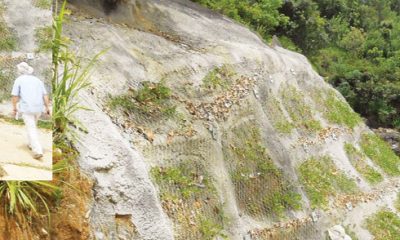
 Features6 days ago
Features6 days agoThe Catastrophic Impact of Tropical Cyclone Ditwah on Sri Lanka:
-

 News5 days ago
News5 days agoRising water level in Malwathu Oya triggers alert in Thanthirimale




